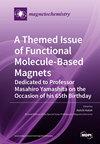用133Cs, 7Li和31P溶液核磁共振光谱和理论核磁共振激光模型估计辐射阻尼率
IF 2.5
4区 化学
Q2 CHEMISTRY, INORGANIC & NUCLEAR
引用次数: 0
摘要
在核磁共振中使用受激辐射(激光)效应的无线电放大可以随着时间的推移增加核磁共振信号,这是由于样品磁化和探针线圈之间的反馈回路加上辐射阻尼(RD)。在此之前,只直接观察到1H、3He、17O和129Xe原子核的RD速率。我们报告了用传统的核磁共振探针从核磁共振激光发射中测定高浓度溶液中三种异核(133Cs (I = 7/2), 7Li (I = 3/2)和31P (I = 1/2)的RD时间常数的实验直接测量。在RD速率超过横向弛豫速率的条件下(即满足NMR RASER条件),我们记录了横向NMR RASER对不完全反演的响应和纵向磁化的恢复。根据著名的Bloom模型对数据进行直接评估,估计133c、7Li和31P的RD速率常数分别为8.0、1.8和25 Hz。所提出的方法也可以应用于其他原子核的RD速率常数的观测。本文章由计算机程序翻译,如有差异,请以英文原文为准。
Estimation of Radiation Damping Rates Using 133Cs, 7Li and 31P Solution NMR Spectroscopy and a Theoretical NMR RASER Model
Radio amplification using stimulated emission of radiation (RASER) effects in the NMR can increase NMR signals over time due to a feedback loop between the sample magnetization and the probe coil coupled with radiation damping (RD). Previously, RD rates had been directly observed only for the 1H, 3He, 17O and 129Xe nuclei. We report that experimental direct measurements of an NMR RASER to determine RD time constants for the three heteronuclei (133Cs (I = 7/2), 7Li (I = 3/2) and 31P (I = 1/2)) in a highly concentrated solution from the NMR RASER emissions using a conventional NMR probe. Under conditions where the RD rate exceeds the transverse relaxation rate (i.e., the NMR RASER condition is fulfilled), we recorded both the transverse NMR RASER response to imperfect inversion and the recovery of longitudinal magnetization. The data were directly evaluated based on the well-known Bloom model as estimated RD rate constants of 8.0, 1.8 and 25 Hz for 133Cs, 7Li and 31P, respectively. The proposed method can be applied to observe RD rate constants for the other nuclei as well.
求助全文
通过发布文献求助,成功后即可免费获取论文全文。
去求助
来源期刊

Magnetochemistry
Chemistry-Chemistry (miscellaneous)
CiteScore
3.90
自引率
11.10%
发文量
145
审稿时长
11 weeks
期刊介绍:
Magnetochemistry (ISSN 2312-7481) is a unique international, scientific open access journal on molecular magnetism, the relationship between chemical structure and magnetism and magnetic materials. Magnetochemistry publishes research articles, short communications and reviews. Our aim is to encourage scientists to publish their experimental and theoretical results in as much detail as possible. Therefore, there is no restriction on the length of the papers. The full experimental details must be provided so that the results can be reproduced.
 求助内容:
求助内容: 应助结果提醒方式:
应助结果提醒方式:


